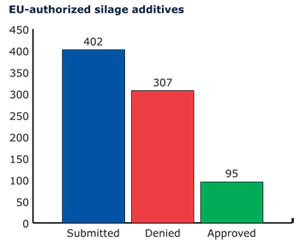
Silage additives: Can they cut the mustard in the EU?
 By Jon Urness In America, we’re proud to say we live in the land of the free. And, most often, that’s a good thing. But when it comes to silage additives and how they’re scrutinized and marketed, maybe we’d have to say not-so-much. Here in the land of wide open spaces and free markets, it’s fairly easy to put together a silage additive simply by choosing a few likely characters for bacteria, mixing them in a bottle, slapping on a label, and touting it as being well-researched and proven, with little or no interference from regulators such as FDA. Like it or not, we do enjoy a fair amount of freedom here in the U.S. that allows some of this to go on, but it’s a far different story in the European Union where our Crop-N-Rich MTD/1 is also marketed. While EU regulations can be frustrating to grain marketers in the U.S., forage producers can be assured that Crop-N-Rich MTD/1 has been closely scrutinized long before it ever reaches their farms. I had a chance recently to visit with David Pickard, regulatory manager for Ecosyl Products, LTD in Stokesley, U.K. According to him, about 10 years ago, the EU Food Safety Authority determined that silage additives should be classified as feed additives and, therefore, must require authorization for their sale and distribution. Products that are not approved cannot be marketed. Five areas of documentation are required in order to receive authorization:
By Jon Urness In America, we’re proud to say we live in the land of the free. And, most often, that’s a good thing. But when it comes to silage additives and how they’re scrutinized and marketed, maybe we’d have to say not-so-much. Here in the land of wide open spaces and free markets, it’s fairly easy to put together a silage additive simply by choosing a few likely characters for bacteria, mixing them in a bottle, slapping on a label, and touting it as being well-researched and proven, with little or no interference from regulators such as FDA. Like it or not, we do enjoy a fair amount of freedom here in the U.S. that allows some of this to go on, but it’s a far different story in the European Union where our Crop-N-Rich MTD/1 is also marketed. While EU regulations can be frustrating to grain marketers in the U.S., forage producers can be assured that Crop-N-Rich MTD/1 has been closely scrutinized long before it ever reaches their farms. I had a chance recently to visit with David Pickard, regulatory manager for Ecosyl Products, LTD in Stokesley, U.K. According to him, about 10 years ago, the EU Food Safety Authority determined that silage additives should be classified as feed additives and, therefore, must require authorization for their sale and distribution. Products that are not approved cannot be marketed. Five areas of documentation are required in order to receive authorization:
- Public and scientific studies
- Identity and condition of use of the additive
- Study of safety, including safety to animals, consumers, the environment and workers
- Studies concerning efficacy
- Post-market monitoring
The documentation to fulfill these requirements is extensive and expensive to produce. Ecosyl Products, LTD submitted 10 boxes of documentation. The estimated cost to produce this documentation was $640,000. And that’s with no guarantee that authorization would be granted.  Of the 2,616 substances submitted as feed additives under these new regulations, only 43 percent were approved. That means 57 percent of the feed additives submitted received an eventual ban. Breaking out silage additives from this group, it’s clear to see that cutting the mustard was even more difficult for silage inoculants. Of 402 silage additives submitted for authorization, only 95 (24 percent) were approved, including L. plantarum MTD/1 as found in our Crop-N-Rich. With all the wanna-be and look-alike forage inoculants on the market in the U.S., it makes me wonder how they would stand up to the scrutiny of the EU food safety law. Granted, these laws don’t apply here, but, as time goes on, Pickard is fairly certain the requirements in the U.S. and the EU will become more similar than different. In the meantime, when evaluating any forage product here in America, insist on seeing the proof of performance and what standards have been applied to back up statements of effectiveness. About the author: Jon Urness is the Vita Plus national forage specialist. He grew up on his family’s five-generation homestead dairy near Black Earth, Wis. and still lives there today. He graduated from the University of Wisconsin-Madison in 1977 with a bachelor’s degree in agricultural journalism. Since 1992, Urness has provided on-farm dairy nutrition consulting in southwest Wisconsin as a Vita Plus employee owner. He has also taken on the forage marketing responsibilities outside of the traditional Vita Plus market.
Of the 2,616 substances submitted as feed additives under these new regulations, only 43 percent were approved. That means 57 percent of the feed additives submitted received an eventual ban. Breaking out silage additives from this group, it’s clear to see that cutting the mustard was even more difficult for silage inoculants. Of 402 silage additives submitted for authorization, only 95 (24 percent) were approved, including L. plantarum MTD/1 as found in our Crop-N-Rich. With all the wanna-be and look-alike forage inoculants on the market in the U.S., it makes me wonder how they would stand up to the scrutiny of the EU food safety law. Granted, these laws don’t apply here, but, as time goes on, Pickard is fairly certain the requirements in the U.S. and the EU will become more similar than different. In the meantime, when evaluating any forage product here in America, insist on seeing the proof of performance and what standards have been applied to back up statements of effectiveness. About the author: Jon Urness is the Vita Plus national forage specialist. He grew up on his family’s five-generation homestead dairy near Black Earth, Wis. and still lives there today. He graduated from the University of Wisconsin-Madison in 1977 with a bachelor’s degree in agricultural journalism. Since 1992, Urness has provided on-farm dairy nutrition consulting in southwest Wisconsin as a Vita Plus employee owner. He has also taken on the forage marketing responsibilities outside of the traditional Vita Plus market.
| Category: |
Dairy Performance Forage inoculants Silages |

